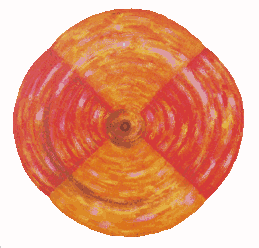Hello to all yogis and yoginis,
As those of you who have been coming to my classes know, I like to work with themes. A theme seems to give structure and form to the practice and anchors us in the rich and deep art of yoga. So I'm kicking off the year in term 1 with an introduction to the esoteric energy centres known as the cakras. We will start with a general introduction and then move onto the root cakra Muladhara and thereafter travel up the spine to the other 6 cakras. Each week we learn a little about a different cakra: name, background colour, mantra, yantra, element, domain and approximate location. This will be linked in with learning how to move our spines safely from the navel spine up one vertebra at a time. In addition, each class will focus a couple of poses to investigate how the chosen cakra plays out in the physical postures and close with a short meditation before savasana or a yoga nidra.
I have used Alan Finger’s conception of the cakras for classes (see reference list) and included here the information I used from his book to guide my teachings. The order is as follows location, colour, mantra, yantra, element, domain, and gland (some texts note loose mapping onto endocrine system.
The first cakra: Muladhara
Image source : http://www.anandgholap.net/Chakras-CWL.htm
The first cakra is Muladhara. 'Mula' translates as 'root', 'base', or 'beginning'. 'Hara' means centre so together muladhara could translate as base or root of our being or centre of our physical world. Muladhara is represents by the earth element and connects us to our source of sustenance and our sense of stability. In a sense, it is your source of stability and security in the material world: how you handle money, family, your body- in essence your roots. It is located at the base of the spine between the tailbone (cocyx), pubic bone and sitting bones(ischial tuberosities). The colour associated with the base cakra is red and its yantra is a golden square (Note: there are various and quite different visual representations of each cakra e.g. teh one above is CW Leadbeater visual for the base cakra). The mantra is LAM.
Poses:
Mountain pose or tadasana (foot stability)
Standing poses e.g lunges or the warrior series
Seated postures whereby the sitting bones take on the role of the feet in setting a firm foundation
Poses:
Mountain pose or tadasana (foot stability)
Standing poses e.g lunges or the warrior series
Seated postures whereby the sitting bones take on the role of the feet in setting a firm foundation
Background information:
There are many texts,
ideas and interpretations on and about the cakras (pronounced chakras ‘ch’ as in church
but spelt ‘cakra’), thus what follows is my current understanding of the cakras. If
you are interested in this topic I have listed the texts I have drawn from and you
can read them and come to your own conclusions.
The earliest written account of the Cakras is believed
to be part of the Vedas. The Vedas are said to originate between 2,000 - 6000
B.C. They have been studied and verified by countless scientists and
researchers, for example, Dr. Hiroshi Motoyama and Dr Valerie Hunt of the
University of California.
The Cakras are, generally speaking, concerned with the
heightening of the consciousness in an individual. The term consciousness
is a way of referring to an individual’s state of mind and so the Cakras are
tied to a being’s psychological issues and the mental development.
There are
generally considered to be 7 main cakras although according to some texts there
are more - possibly hundreds. The first Cakra is found at the base of the spine
and is generally believed to relate to survival aspects. By ascending up
the Cakras it is believed an individual achieves a higher level of consciousness
to the point where they are voluntarily released from the bondage of the greed,
hate and anger that originally brought about an indiviudal’s confused state
of mind. When the very top is reached an individual can truly begin to
understand their connectivity to all things and realise the purpose of their existence
otherwise referred to as enlightenment, nirvana or Samadhi.
References
Anodea, J., Eastern body, Western mind:
Psychology and the chakra system as a path to self, Celestial Arts, 2004.
Finger, A., Chakra Yoga: Balancing energy
for physical, spiritual, mental well-being, Shambhala, Boston & London,
2005.
Motoyama, H, Dr., Theories of the Chakras:
Bridge to higher consciousness, New Age Books, 2003
Motoyama, H, Dr., The Awakening the chakras
and
emancipation
, New Age Books, 2003



No comments:
Post a Comment